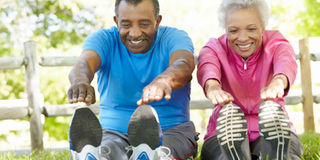Safe exercise for heart disease patients

Your doctor can let you know what activities are okay for you. You may have more options than you think. Stock photo
What you need to know:
- Dr Kakande says a doctor will advise when to resume exercising if the patient has severely high resting blood pressure where the systolic blood pressure level is equal or greater than 200mmHg and the diastolic blood pressure level is greater than or equal to 110mmHg, when the person’s heart rate is higher than 100bpm or when sugar levels are greater than 11.1mmom
Speaking to Dr Barbara Kakande, a cardiologist at UMC Victoria Hospital, I got the shock of my life, “heart disease is no impediment for exercising,” she said. That demystified the myth that many of us have, that persons with heart disease cannot exercise.
As if the first shock was not enough, she said, we need to exercise for no less than 30 minutes because in the first 15 minutes, you are only burning up the sugars. “I only exercise for three minutes,” I said coyly. With shock on her face, Dr Kakande said, “Being small does not mean you cannot get a heart problem. You have conditioned your heart to being rather inactive and while you may look petite and young on the outside, your inside is aging away.”
When one has heart issues, there has to be an exercise programme designed to meet their individual needs as conditions differ.
“The programme is designed by a physiotherapist and discussed with the person’s cardiologist. The cardiologist will be updated whenever necessary,” Quraish Golooba, a physiotherapist at Case Medical Centre, shares.
Benefits
Dr Kakande says exercising will improve the respiratory and cardiac function of the person, quickens one’s getting back to their previous functional capacity or go back to work fast and reduces or prevents symptoms such as restlessness and dizziness.
Before exercising
Seeing that one’s heart has suffered some damage, Golooba advises that some tests must be done and these include physical tests to see the level and intensity of exercises one can do. These include six-minute walk tests and shuttle walk tests. “These help to see how far one can walk fast without resting and are done at the start of the programme or when the physiotherapist is evaluating the programme,” Golooba advises.
They also help the physiotherapist get the maximum heart beat that the patient can reach when exercising. Beyond that rate, the person must stop working out.
Medical tests are also carried out. These are done to assess the condition of one’s vital organs and are done before one starts exercising. These include heart rate, blood pressure and glucose levels. Both dictate if they can do any exercise at all, what the person can or cannot do as well as the intensity.
Warm up
These are a must before the real exercises to prepare the body by gradually raising the heart rate in a safe manner. Warm up workouts include stretching to prevent fatigue as it increases flexibility and the focus is on the core muscles – hamstring and cuff muscles. Another is deep breathing exercises to avail the body with the needed oxygen. One can also indulge in jogging or running on the spot.
There are two types of exercises that these persons can do: Aerobics (brisk walking, swimming, running, cycling, rowing, dancing, and boxing) and resistance training (using dumb bells, and resistance bands). “The exercises are gradual, for example if one is to run, they would start with jogging and as the heart continues getting acclimatised, they progress. Besides that, the type and intensity of exercise is determined by the physiotherapist who continually assesses the person’s ability,” Golooba says.
Cooling down
These are meant to bring the body back to the resting status as the activities reduce the heart beat back to normal. These workouts include, stretching, and deep breathing.
When not to exercise
Dr Kakande says a doctor will advise when to resume exercising if the patient has severely high resting blood pressure where the systolic blood pressure level is equal or greater than 200mmHg and the diastolic blood pressure level is greater than or equal to 110mmHg, when the person’s heart rate is higher than 100bpm or when sugar levels are greater than 11.1mmom
She adds that other conditions to look out for include unstable angina or chest pain caused by reduced blood flow to the heart which means that the heart is pumping blood in an irregular manner.
Caution
• If you feel dizzy or breathlessness, stop exercising.
• When you are going to exercise, there should be access to medical help in case of emergency.
• Take your medication promptly as exercising is only possible when the heart condition is well managed.




